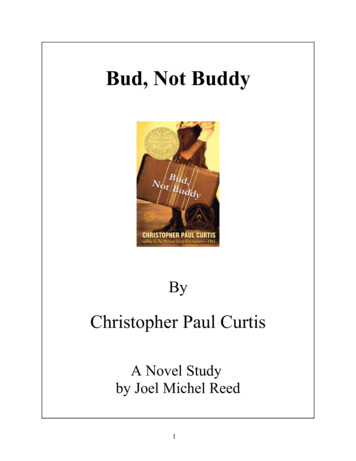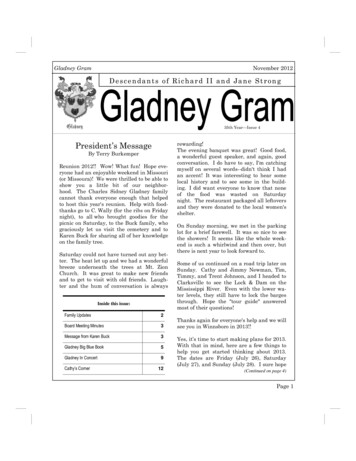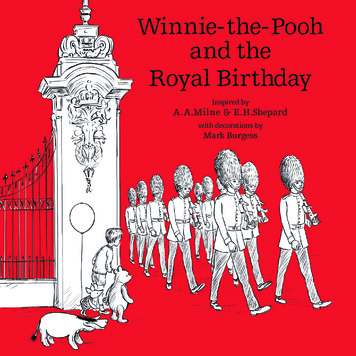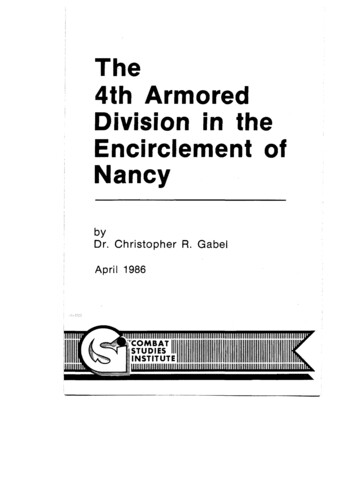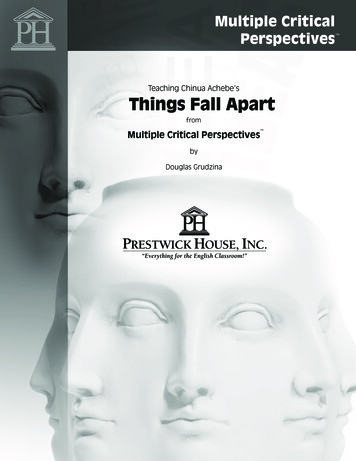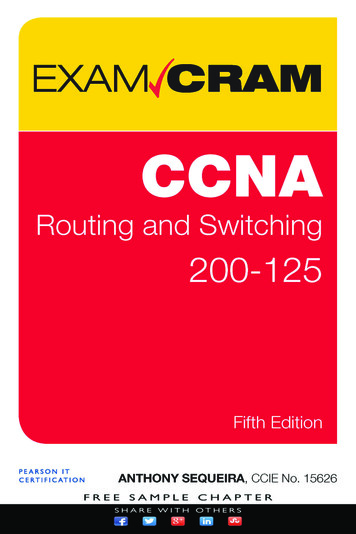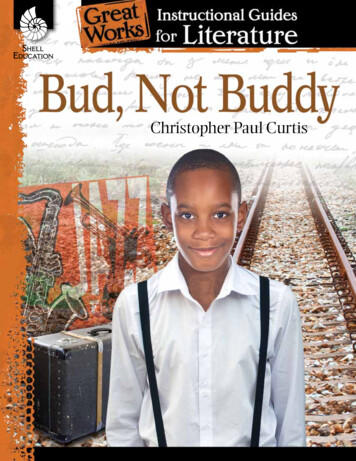
Transcription
Christopher Paul Curtis
Table of ContentsHow to Use This Literature Guide . . . . . . . . . . . . . . . . . . . . . . . . . . . . . . . . . . . . 4Theme Thoughts. . . . . . . . . . . . . . . . . . . . . . . . . . . . . . . . . . . . . . . . . . . . . . . . .Vocabulary. . . . . . . . . . . . . . . . . . . . . . . . . . . . . . . . . . . . . . . . . . . . . . . . . . . . . .Analyzing the Literature. . . . . . . . . . . . . . . . . . . . . . . . . . . . . . . . . . . . . . . . . .Reader Response. . . . . . . . . . . . . . . . . . . . . . . . . . . . . . . . . . . . . . . . . . . . . . . . .Close Reading the Literature. . . . . . . . . . . . . . . . . . . . . . . . . . . . . . . . . . . . . . .Making Connections . . . . . . . . . . . . . . . . . . . . . . . . . . . . . . . . . . . . . . . . . . . . .Creating with the Story Elements. . . . . . . . . . . . . . . . . . . . . . . . . . . . . . . . . . .Culminating Activity. . . . . . . . . . . . . . . . . . . . . . . . . . . . . . . . . . . . . . . . . . . . .Comprehension Assessment. . . . . . . . . . . . . . . . . . . . . . . . . . . . . . . . . . . . . . .Response to Literature. . . . . . . . . . . . . . . . . . . . . . . . . . . . . . . . . . . . . . . . . . . .4566677888Correlation to the Standards. . . . . . . . . . . . . . . . . . . . . . . . . . . . . . . . . . . . . . . . . . . 8Standards Correlation Chart. . . . . . . . . . . . . . . . . . . . . . . . . . . . . . . . . . . . . . . 9TESOL and WIDA Standards. . . . . . . . . . . . . . . . . . . . . . . . . . . . . . . . . . . . . 10About the Author—Christopher Paul Curtis. . . . . . . . . . . . . . . . . . . . . . . . . . . 11Book Summary of Bud, Not Buddy. . . . . . . . . . . . . . . . . . . . . . . . . . . . . . . . . . . .Possible Texts for Text Comparisons. . . . . . . . . . . . . . . . . . . . . . . . . . . . . . .Cross-Curricular Connection . . . . . . . . . . . . . . . . . . . . . . . . . . . . . . . . . . . . .Possible Texts for Text Sets . . . . . . . . . . . . . . . . . . . . . . . . . . . . . . . . . . . . . . .12121212Pre-Reading Theme Thoughts. . . . . . . . . . . . . . . . . . . . . . . . . . . . . . . . . . . . . . . 13Section 1: Chapters 1–3. . . . . . . . . . . . . . . . . . . . . . . . . . . . . . . . . . . . . . . . . . . . . 14Section 2: Chapters 4–8. . . . . . . . . . . . . . . . . . . . . . . . . . . . . . . . . . . . . . . . . . . . . 24Section 3: Chapters 9–11. . . . . . . . . . . . . . . . . . . . . . . . . . . . . . . . . . . . . . . . . . . . 34Section 4: Chapters 12–14. . . . . . . . . . . . . . . . . . . . . . . . . . . . . . . . . . . . . . . . . . . 44Section 5: Chapters 15–19. . . . . . . . . . . . . . . . . . . . . . . . . . . . . . . . . . . . . . . . . . . 54Post-Reading Activities. . . . . . . . . . . . . . . . . . . . . . . . . . . . . . . . . . . . . . . . . . . . .Post-Reading Theme Thoughts . . . . . . . . . . . . . . . . . . . . . . . . . . . . . . . . . . .Culminating Activity: Transformations. . . . . . . . . . . . . . . . . . . . . . . . . . . . .Comprehension Assessment. . . . . . . . . . . . . . . . . . . . . . . . . . . . . . . . . . . . . .Response to Literature: Make Your Case!. . . . . . . . . . . . . . . . . . . . . . . . . . .6464656769Answer Key . . . . . . . . . . . . . . . . . . . . . . . . . . . . . . . . . . . . . . . . . . . . . . . . . . . . . . . 71 Shell Education #40202—Instructional Guide: Bud, Not Buddy3
IntroductionHow to Use This Literature GuideToday’s standards demand rigor and relevance in the reading of complex texts. Theunits in this series guide teachers in a rich and deep exploration of worthwhile worksof literature for classroom study. The most rigorous instruction can also be interestingand engaging!Many current strategies for effective literacy instruction have been incorporatedinto these instructional guides for literature. Throughout the units, text-dependentquestions are used to determine comprehension of the book as well as studentinterpretation of the vocabulary words. The books chosen for the series are complexand exemplars of carefully crafted works of literature. Close reading is usedthroughout the units to guide students toward revisiting the text and using textualevidence to respond to prompts orally and in writing. Students must analyze thestory elements in multiple assignments for each section of the book. All of thesestrategies work together to rigorously guide students through their studyof literature.The next few pages will make clear how to use this guide for a purposeful andmeaningful literature study. Each section of this guide is set up in the same way tomake it easier for you to implement the instruction in your classroom.Theme ThoughtsThe great works of literature used throughout this series have important themes thathave been relevant to people for many years. Many of the themes will be discussedduring the various sections of this instructional guide. However, it would also benefitstudents to have independent time to think about the key themes of the novel.Before students begin reading, have them complete Pre-Reading Theme Thoughts(page 13). This graphic organizer will allow students to think about the themesoutside the context of the story. They’ll have the opportunity to evaluate statementsbased on important themes and defend their opinions. Be sure to have studentskeep their papers for comparison to the Post-Reading Theme Thoughts (page 64). Thisgraphic organizer is similar to the pre-reading activity. However, this time, studentswill be answering the questions from the point of view of one of the characters of thenovel. They have to think about how the character would feel about each statementand defend their thoughts. To conclude the activity, have students compare whatthey thought about the themes before the novel to what the characters discoveredduring the story.4#40202—Instructional Guide: Bud, Not Buddy Shell Education
IntroductionHow to Use This Literature Guide (cont.)VocabularyEach teacher overview page has definitions and sentences about how key vocabularywords are used in the section. These words should be introduced and discussedwith students. There are two student vocabulary activity pages in each section. Onthe first page, students are asked to define the ten words chosen by the author ofthis unit. On the second page in most sections, each student will select at least eightwords that he or she finds interesting or difficult. For each section, choose one ofthese pages for your students to complete. With either assignment, you may wantto have students get into pairs to discuss the meanings of the words. Allow studentsto use reference guides to define the words. Monitor students to make sure thedefinitions they have found are accurate and relate to how the words are used inthe text.On some of the vocabulary student pages, students are asked to answer text-relatedquestions about the vocabulary words. The following question stems will help youcreate your own vocabulary questions if you’d like to extend the discussion. How does this word describe ’s character? In what ways does this word relate to the problem in this story? How does this word help you understand the setting? In what ways is this word related to the story’s solution? Describe how this word supports the novel’s theme of . . . . What visual images does this word bring to your mind? For what reasons might the author have chosen to use this particular word?At times, more work with the words will help students understand their meanings.The following quick vocabulary activities are a good way to further study the words. Have students practice their vocabulary and writing skills by creating sentencesand/or paragraphs in which multiple vocabulary words are used correctly andwith evidence of understanding. Students can play vocabulary concentration. Students make a set of cards withthe words and a separate set of cards with the definitions. Then, students laythe cards out on the table and play concentration. The goal of the game is tomatch vocabulary words with their definitions. Students can create word journal entries about the words. Students choosewords they think are important and then describe why they think each word isimportant within the book. Shell Education #40202—Instructional Guide: Bud, Not Buddy5
IntroductionHow to Use This Literature Guide (cont.)Analyzing the LiteratureAfter students have read each section, hold small-group or whole-class discussions.Questions are written at two levels of complexity to allow you to decide whichquestions best meet the needs of your students. The Level 1 questions are typicallyless abstract than the Level 2 questions. Level 1 is indicated by a square, while Level2 is indicated by a triangle.These questions focus on the various story elements, such as character, setting, andplot. Student pages are provided if you want to assign these questions for individualstudent work before your group discussion. Be sure to add further questions as yourstudents discuss what they’ve read. For each question, a few key points are providedfor your reference as you discuss the novel with students.Reader ResponseIn today’s classrooms, there are often great readers who are below average writers. Somuch time and energy is spent in classrooms getting students to read on grade level,that little time is left to focus on writing skills. To help teachers include more writing intheir daily literacy instruction, each section of this guide has a literature-based readerresponse prompt. Each of the three genres of writing is used in the reader responseswithin this guide: narrative, informative/explanatory, and opinion/argument.Students have a choice between two prompts for each reader response. One responserequires students to make connections between the reading and their own lives. Theother prompt requires students to determine text-to-text connections or connectionswithin the text.Close Reading the LiteratureWithin each section, students are asked to closely reread a short section of text. Sincesome versions of the novels have different page numbers, the selections are describedby chapter and location, along with quotations to guide the readers. After each closereading, there are text-dependent questions to be answered by students.Encourage students to read each question one at a time and then go back to the textand discover the answer. Work with students to ensure that they use the text todetermine their answers rather than making unsupported inferences. Once studentshave answered the questions, discuss what they discovered. Suggested answers areprovided in the answer key.6#40202—Instructional Guide: Bud, Not Buddy Shell Education
IntroductionHow to Use This Literature Guide (cont.)Close Reading the Literature (cont.)The generic, open-ended stems below can be used to write your own text-dependentquestions if you would like to give students more practice. Give evidence from the text to support . . . . Justify your thinking using text evidence about . . . . Find evidence to support your conclusions about . . . . What text evidence helps the reader understand . . . ? Use the book to tell why happens. Based on events in the story, . . . . Use text evidence to describe why . . . .Making ConnectionsThe activities in this section help students make cross-curricular connections towriting, mathematics, science, social studies, or the fine arts. In some of these lessons,students are asked to use the author as a mentor. The writing in the novel modelsa skill for them that they can then try to emulate. Students may also be asked tolook for examples of language conventions within the novel. Each of these types ofactivities requires higher-order thinking skills from students.Creating with the Story ElementsIt is important to spend time discussing the common story elements in literature.Understanding the characters, setting, and plot can increase students’ comprehensionand appreciation of the story. If teachers discuss these elements daily, students willmore likely internalize the concepts and look for the elements in their independentreading. Another very important reason for focusing on the story elements is thatstudents will be better writers if they think about how the stories they read areconstructed.Students are given three options for working with the story elements. They are askedto create something related to the characters, setting, or plot of the novel. Studentsare given choice on this activity so that they can decide to complete the activity thatmost appeals to them. Different multiple intelligences are used so that the activitiesare diverse and interesting to all students. Shell Education #40202—Instructional Guide: Bud, Not Buddy7
Teacher PlansÑSection 1Chapters 1–3Analyzing the LiteratureProvided below are discussion questions you can use in small groups, with the wholeclass, or for written assignments. Each question is given at two levels so you can choosethe right question for each group of students. Activity sheets with these questions areprovided (pages 18–19) if you want students to write their responses. For each question,a few key discussion points are provided for your reference.StoryElement Level 1Discuss how hard it is to be anolder foster child and knowthat you’ll be the underdog andquite possibly bullied. Alsodiscuss the general feeling ofhelplessness as an orphan.Contrast Bud’spersonality withTodd’s. How are theyalike? Different?Although Todd is a ratherunlikeable character, bring outhow Todd might be threatenedby having a younger boy in thehome. If time allows, explorehow Todd manipulates hisparents.What is it like in theshed?How does the authormake you feel likeyou are in the shedwith Bud?Discuss the presence of thespider webs, bugs, the fish-headguards, the hornet nest, andthe darkness. Contrast the realwith the imagined (vampires).If time allows, relate the settingto the set-up by Todd with hisdescription of what previouslyhappened to other kids.Why is Bud mad atthe Amoses and athimself?Bud says that beingscared gives youstrength. How? He isalso angry. Describehow his anger andfear affect his actions.Bud resents being locked upand for being susceptible to thethreat of vampires. The feargives him strength to get out ofthe shed. Between the fear andthe anger, he is ready to seek hisrevenge on the Amos family.PlotCharacterWhy do you thinkTodd starts the fightwith Bud? Whowould you choose fora friend?Character Shell Education Key Discussion PointsLevel 2Think about how thebook begins: Here wego again. How doesBud draw on his priorexperiences to helpJerry? How does Budreally feel?How do Bud andJerry react to thenews that they arebeing moved to fosterhomes?Setting #40202—Instructional Guide: Bud, Not Buddy17
Chapters 1–3NameDateAnalyzing the LiteratureDirections: Think about the section you have just read. Read each question andstate your response with textual evidence.1. How do Bud and Jerry react to the news that they are being moved to fosterhomes?2. Why do you think Todd starts the fight with Bud? Who would you choose fora friend?3. What is it like in the shed?4. Why is Bud mad at the Amoses and at himself?18#40202—Instructional Guide: Bud, Not Buddy Shell Education
NameChapters 1–3DateAnalyzing the LiteratureDirections: Think about the section you have just read. Read each question andstate your response with textual evidence.1. Think about how the book begins: Here we go again. How does Bud draw on hisprior experiences to help Jerry? How does Bud really feel?2. Contrast Bud’s personality with Todd’s. How are they alike? Different?3. How does the author make you feel like you are in the shed with Bud?4. Bud says that being scared gives you strength. How? He is also angry.Describe how his anger and fear affect his actions. Shell Education #40202—Instructional Guide: Bud, Not Buddy19
NameChapters 1–3DateClose Reading the LiteratureDirections: Closely reread the section in the last half of chapter 1, beginning withthe paragraph that opens with “The paper was starting to wear out . . .” Continuereading to the end of the chapter. Read each question and then revisit the text tofind the evidence that supports your answer.1. Use the book to describe how Bud keeps the flyers and why they are gettingworn out.2. According to the paragraph about the picture of him standing with his “giantfiddle,” what does Herman E. Calloway look like?3. Use the text to identify the characteristics Bud decides his father must have.4. Bud describes how his mother got upset when looking at a flyer. Do you thinkthat is enough evidence to prove that Herman E. Calloway is Bud’s father?Justify your answer based on what you’ve read in this section. Shell Education #40202—Instructional Guide: Bud, Not Buddy21
Chapters 1–3NameDateCreating with the Story ElementsDirections: Thinking about the story elements of character, setting, and plot in anovel is very important to understanding what is happening and why. Completeone of the following activities about what you’ve read so far. Be creative andhave fun!CharactersCreate a character reportcard for Mrs. Todd. List atleast six character traits onit, such as kindness. Then,give her a grade for eachcategory. Include a “teachercomment” that explainsyour reason for each grade.SettingCreate a diorama or drawing ofthe shed. Review chapter 3 toinclude the features of the shedthat are particularly frighteningto Bud.PlotAt the end of chapter 3, Bud says that he will get hisrevenge. List three choices he might make next. Thenidentify the possible good and bad consequences foreach choice. Record your answers in a chart like thison another piece of paper.Choice Shell Education Possible Good ConsequencePossible Bad Consequence#40202—Instructional Guide: Bud, Not Buddy23
How do Bud and Jerry react to the news that they are being moved to foster homes? Think about how the book begins: Here we go again. How does Bud draw on his prior experiences to help Jerry? How does Bud really feel? Discuss how hard it is to be an older foster child and know that
